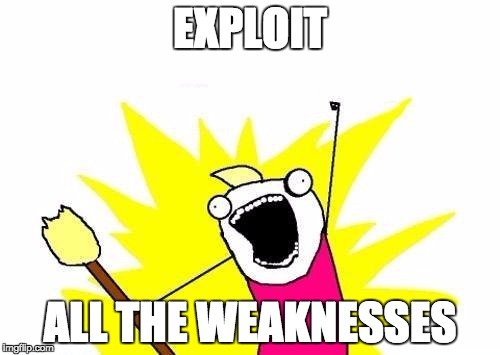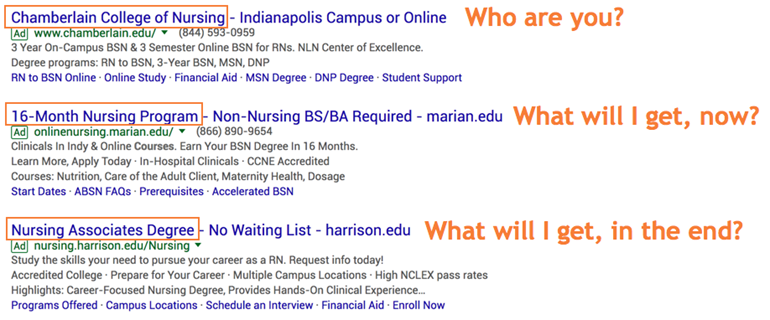Competition is literally the foundation of our industry. If it were not for the strategy behind competing in the auction, machines would be more than capable of carrying the duties of PPC and the world would have less PPC unicorns.
It’s safe to say that most of us are, at the very least, aware of who our competitors are, but are you watching them and studying them? Do you know how they’re approaching users in ads and landing pages? Do you know what their value proposition is and what makes them unique?
As Mark Cuban once said, “Information is power, particularly when the competition ignores the opportunity to do the same.” If you’re not “in the know” concerning your top competitors, what’s to say that they aren’t studying you and exploiting your weaknesses with little to no opposition from you?
[bctt tweet=”If you don’t have a competitive advantage, don’t compete. – Jack Welsh” username=”katewilcoxkcco”]
Removing our PPC world blinders, in almost every single sport, coaches and players spend endless amounts of time studying their competition. Why? Because it pays off. There are numerous benefits, but do you honestly think that folks would spend that much time watching games on repeat to identify strategies and weaknesses if it didn’t pay off in the end? Yeah. Me neither. So let’s take some notes from the sports world and really take the time to dig into our competition.

When approaching any type of analysis, you should have goals in mind and questions you need answered.
[bctt tweet=”Never go into an analysis as an open slate. Dig for specific nuggets of information.” username=”katewilcoxkcco”]
In this article, I’ll share a handful of goals and questions that you can use to efficiently break down learn about your competition.
Before we get started, here’s the small print that’s absolutely critical. There are times when you need to copy your competitor and times when you need to NOT copy your competitor and these times are always situationally dependent. Sometimes you need to compete by proving that you’re on equal ground and this is when you need to copy your competitor. Other times you need to stand out and be the difference maker and this is when you want nothing to do with copying your competitor. Use your common sense guys and gals, but make sure you evaluate your moves to determine if being the same or different is most powerful in each situation.
What Language Are They Using In Their Ads?
Isolate a few of your competitor’s ads and start breaking them down into building blocks.
What are they saying with the headline? Are they using that space to evoke their brand? Their selling point? The user’s pain point?

The first headline is typically the first piece of copy that will be read so we can safely assume that the first headline is at least important to our competitor. If your competitor places their brand in the first headline, you should probably think about testing a few ads with your brand name in that spot as well. If we go a step further and assume we are dealing with a smart competitor, we can also assume that this ad has been through some ad testing and was a top performer at one point or another.
Overall, are they conveying information or are they selling? When you break the ad into pieces, are each of these pieces simply sharing information about the product or service such as “Shipping to anywhere in the US” or are they selling such as “Free shipping on every order”? One simply pushes more information out there and the other tries to pull you in by angling information.
While this may not isolate the overall strategy they’re using, it does enable you to fight fire with fire. This is where being the difference maker may benefit you. Humans are inherently attracted to breaks in patterns. If your neighbor on the SERP is selling and you’re selling as well, it’s hard for a user to isolate any break in pattern and be attracted to either of you distinctly. So you could be bucketed in with your competitor. If your neighbor is selling and you’re conveying information, it’s very easy to distinguish between the two and the user will choose the ad that speaks best to their mindset. The difference being that you remain distinct in the user’s mind. Even if they don’t choose you, you’ve made a good impression that may pay off in the future.
What Emotions Are They Tapping Into?
Pay attention to the object of their ads and website copy. Are they primarily using personal language that speaks directly to their users such as “you”? Or are they using general language? Are they referring to their users at all or are they keeping it broad or situational?
First and foremost, our ads and websites are showcasing and guiding users to the place where we alleviate their pain points. You should be using the mediums to speak to your users. Sell the experience with your product rather than just your product. If you’re selling an experience, you’re naturally talking to your users and this will create a more personalized response in your user.
Emotional triggers may be difficult to unearth at first, but with practice, you’ll be able to quickly identify what’s tugging on heart strings. Put yourself in a first-time user’s shoes and peruse the competition’s website. Evaluate color scheme, imagery, and copy for emotional triggers. If you aren’t a huge fan of behavioral evaluation, you can simplify this process by taking note of when you feel strongly about something and simply noting the “something” and the feeling. You should be able to draw workable correlations once you’ve isolated these critical variables. You can dig deeper into this with this amazing deck from Talia Wolf’s most recent CXL Live talk.
Implementing color psychology is an insanely effective tactic. Ask any designer about color psychology and you’ll trigger an hour-long educational session on why certain brands use certain colors in their logos all the way down to why schools are painted certain colors. The bottom line is that our environments trigger feelings and when we’re online our screen is our environment so it also triggers feelings. Use those feelings wisely and in your favor. (Take time to place all your competitors’ websites side by side and be amazed by how many of them are using the exact same color palette).
Example: If all your competitors are using varying shades of blue throughout their websites, they’re conveying security, trustworthiness, and neutrality. If your site is not implementing a lot of blue and does not make up for this deficit with copy or badges or anything else, maybe you should be thinking about letting blue to do the work for you.

What are they displaying in their imagery? The product or people using the product? Are there a lot of human faces on their site or no? Do they even have imagery on their site? Imagery is incredibly powerful and can be used to convey your user’s experience after choosing you without using a single word. Use your imagery to help your user envision themselves in a life with your product or service.
Example: If you’re offering adoption coordination services and your competitor’s website displays imagery containing happy babies and children, they are “selling” an emotional experience focused toward users liking those adoptable children. You can one-up this approach by introducing imagery with happy families. Include parents and the full familial unit and you’ll include the future experience with the service; the light at the end of the tunnel that all of those users are seeking.
Where Are The Gaps?
Strive to identify the key differences between your competitors and yourself by comparing and contrasting.
What are your competitors doing that you aren’t, but could be? You may be sitting on a golden egg that you don’t see the value in until you evaluate competitors and spot the lack of a competing offer on their end. You’ll bring more value to yourself and nullify a competitor’s selling point all in one.
Example: If you have free shipping on everything and aren’t emphasizing that and your competitor is showcasing free shipping on items over $50, you have the bigger offer so start pushing it out there so it can compete on even ground.
What are you doing that your competitors are not? Ensure that you draw attention to what your competitor doesn’t have without saying they don’t have it (mudslinging) and without throwing it in your users’ faces (pushy).
Example: If you have a large volume of positive reviews or other strong forms of social proof and you notice that your competitor does not, you are now in possession of a tipping weight. Call out this social proof in your ads, place it in a higher location on your website page so that users see it more quickly.
What Is Important? Where Should I Not Be Focusing?
I know that I am personally capable of overanalyzing every aspect of what I perceive as a personal weakness. This can cause me to lose focus on the overall goal very quickly. The upside is that what you see as your Achilles’ heel may be universal across all your competitors as well. If everyone is weak in one area, that isn’t necessarily your avenue for a quick win.
While you could spend your time and energy ensuring that you are the one business in your sphere that does NOT have that weakness, your time will most likely be better spent optimizing the strengths you already have. Focus on actionable moves that are backed by logic and analysis rather than making gut calls filling gaps that may not need to be filled. These moves may not move the needle and wasted time is the bane of our existence.
Example: If your website hasn’t been redesigned in two to three years, you may think that this is your downfall. “Oh no! We’re so ancient in terms of the current tech field! Everyone will think we’re behind the times! We need to redesign right now to be taken seriously!” If you take the time to browse your competitors’ websites, you may find that they’re just as outdated as you. If everyone is outdated, you’re playing on the same field. While a redesign may help set you apart from everyone else in the long run, it’s most likely not a current catalyst in your performance. To optimize your current performance, you may see more benefit out of sticking to isolating and improving the root problem rather than slapping a band-aid over that root problem.
Final Thoughts
It’s a dog eat dog world out there guys. There are too many benefits of competitor analysis to dive into in a blog post (or 6). Suffice to say that if you’re not performing regular competitor analyses, at least one of your competitors is and if they’re altering their strategy to combat your strategy, you’ve already lost the upper hand or even a sword in the fight by not knowing what they’re doing and how they’re doing it. Use these tips and tricks to get started. Then give me a shout out on Twitter and let me know how you’ve one-upped my tips and leveled up your very own competitor analysis game.




